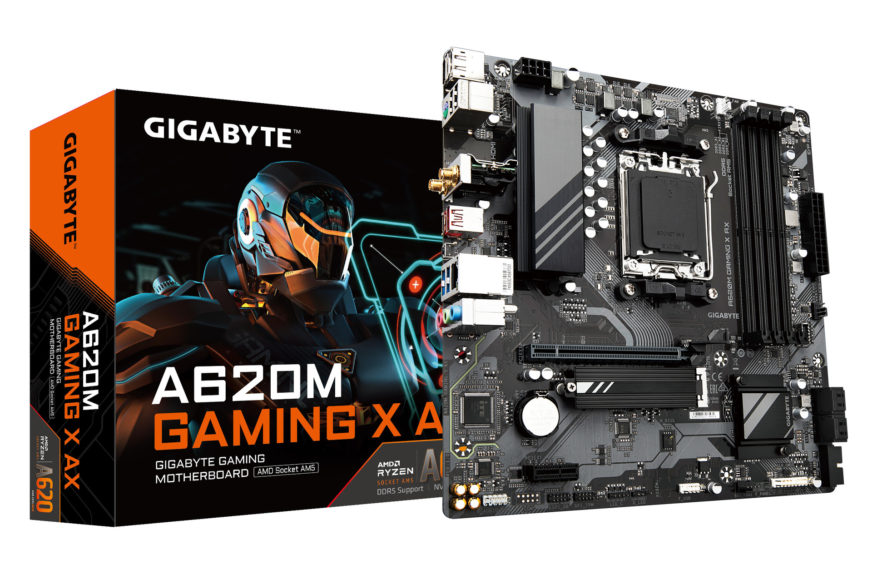A620 motherboards from ASRock, Asus, Biostar, Gigabyte and MSI for 85 to 185 USD
In the last few days, inexpensive A620 chipset-based AM5 motherboards for Ryzen 7000 started leaking. We’ve already seen photos of one model and it seems that AMD has timed the unveiling and release for the last day of March (maybe they wanted to formally make it before the end of the first quarter). And now, boards with this chipset were launched from all the usual manufacturers, with the cheapest ones going as low as $85.
The A620 chipset is simpler than the B650. It provides two to four SATA ports, USB 2.0, USB 3.0 and 10Gb/s USB 3.2 Gen 2 ports, but not the 20Gb/s USB 3.2 Gen 2×2 ports B650 and above provide. Not all boards take advantage of these capabilities, some only provide 5Gb/s USB 3.0 aka 3.2 Gen 1. Boards may be equipped with USB-C.
Compared to the B650 platform, the lanes coming out of the chipset are no longer running at PCIe 4.0 speed, offering only PCIe 3.0, which probably enables the use of lower-cost PCBs. These lanes typically only serve PCIe ×1 slots, so this won’t matter for most uses.
Boards with the A620 chipset come without PCI Express 5.0 support, but provide PCI Express 4.0×16 for GPUs and a pair of PCIe 4.0×4 interfaces for SSDs that are connected to the CPU. Some boards only implement one M.2 slot of these two, but there are some in the lineup that have both. So when it comes to this connectivity, the A650 platform will be a better deal than the AMD B550 while also being significantly more advanced than the existing low-cost A320 and A520 chipset boards. Unlike Intel’s H610 chipsets, manufacturers are allowed to provide four DIMM slots for DDR5 memory on A620 platform boards.
However, the limitation remains that A620 chipset boards will not allow overclocking the processor by changing the clock speed (multiplier) and even overclocking via PBO (Precision Boost Overdrive – regular Precision Boost will be active of course) and Curve Optimizer aren’t allowed either. Only DDR5 memory can be overclocked, both manually and by simply using XMP or AMD EXPO profiles.
The board manufacturers have already revealed the first wave of models, some of which are said to be on sale in Europe already. Also, the current lineup might not be complete, as some brands have only their most baseline basic boards out yet, while others have introduced just the more expensive and better equipped models. According to AMD, the prices of the cheapest boards should start at 85 USD, which is roughly 95 EUR inclusive of 21% VAT (depending on the current exchange rate).
Gigabyte
Representatives of the more expensive and better-equipped boards are the Asus and Gigabyte models. Gigabyte introduced the A620M Gaming X and A620M Gaming X AX models (the latter is the same as the former, but it has Wi-Fi on top). These are boards with four slots for DDR5 memory and a power delivery with 8+2+1 phases, the PCB is six-layer. According to the list of supported CPUs, they should be able to run 170W processors including the Ryzen 9 7950X. The VRM is cooled by a heatsink, and even one of the M.2 slots has a heatsink out of the box. The Gigabyte models only have one PCIe 3.0×1 slot (alongside PCIe 4.0×16 for the GPU).
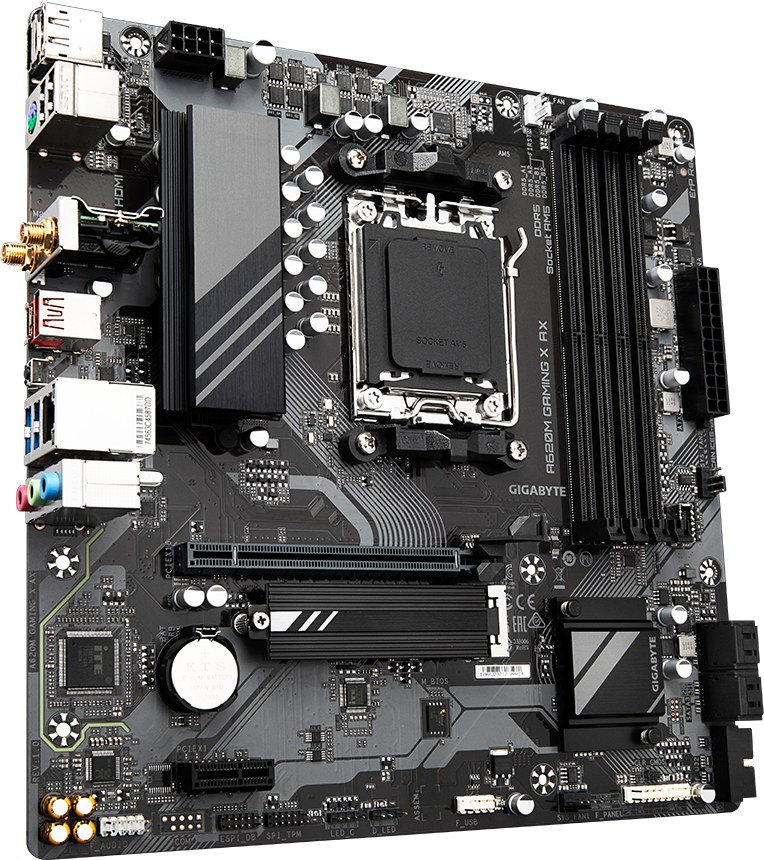
The boards only integrates gigabit Ethernet and the audio will probably be served by Realtek ALC897. On the other hand, that the boards have 10 Gb/s USB-A at the back, which is a plus uncommon amongst A620 boards. And a USB-C port hader is provided for a case front too, which has not been commonplace on past cheap boards. There is a 5Gb/s USB-C on the back as well. The integrated graphics can use HDMI 2.1 and DisplayPort outputs. The AX model is fitted with a Realtek RTL8852CE Wi-Fi 6E (with 6 GHz support) and Bluetooth module.
Asus
Similarly, Asus boards are also aiming for the higher segment. The company has three models, all with four memory slots and this time two PCIe 4.0×4 M.2 slots for NVMe SSDs. And also two PCIe 3.0 ×1 slots, so you can fit more expansion cards. The Prime A620M-A also has gigabit Ethernet only, but the TUF Gaming A620M-Plus goes higher with a 2.5Gb/s Realtek Ethernet.

These boards don’t have USB-C on the back I/O panel, but the USB-C header for the front of the case remains. Unfortunately, no USB port runs at 10Gb/s speed on these boards. The TUF Gaming A620M-Plus Wi-Fi is the same as the base TUF Gaming model, but with an additional wireless module of an unspecified brand, that is capable of Wi-Fi 6 / 802.11ax, Bluetooth 5.3 and has 1×1 antennas.
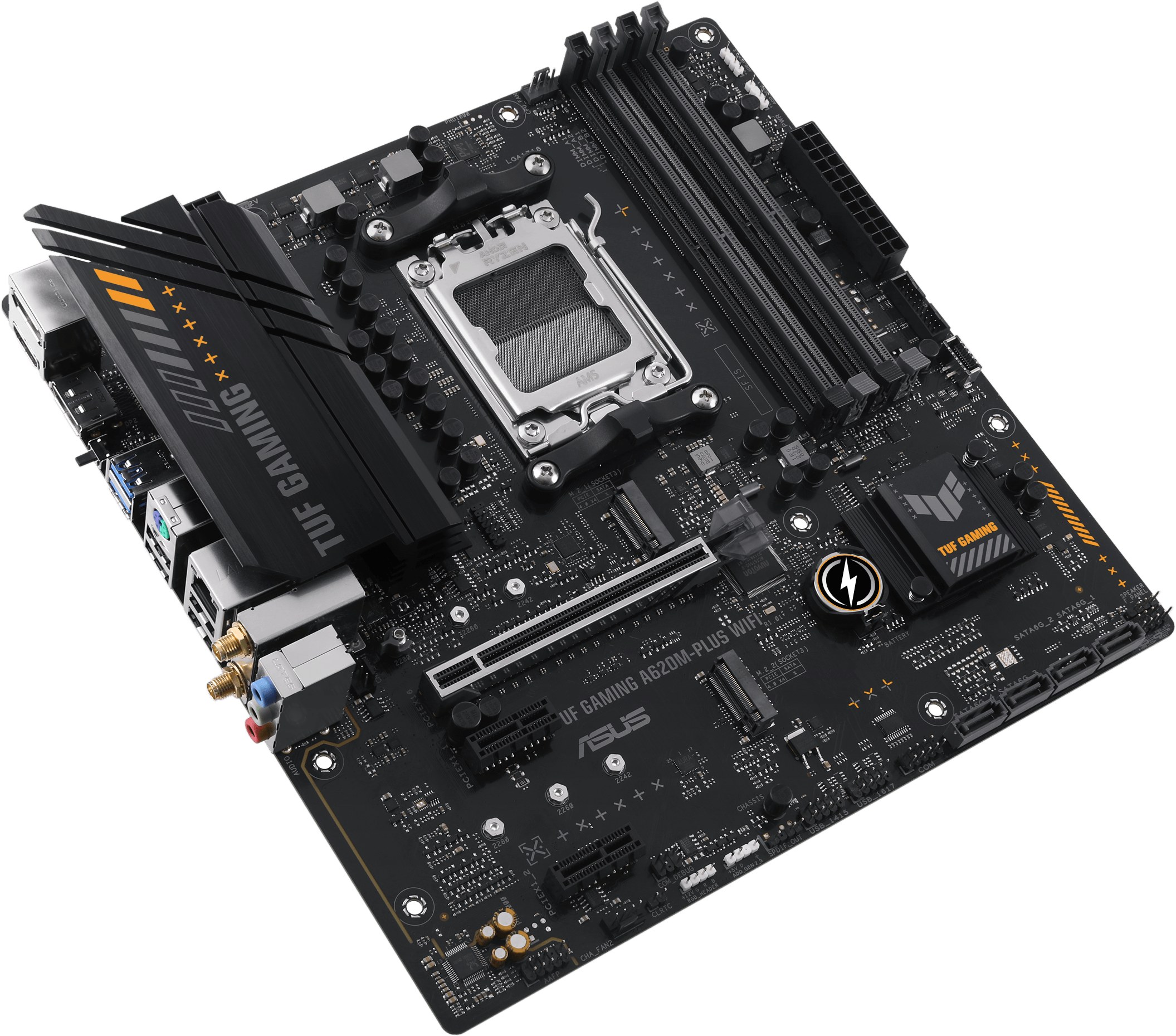
We also know the officially suggested prices for these boards and they will be relatively higher, so they will already overlap with the cheapest boards with the B650 chipset (unless they actually end up in stores for less than the press release states). TUF Gaming A620M-Plus has a suggested price of 149 EUR, the Wi-Fi version is priced at 169 EUR. Asus lists a price of 139 EUR for the Prime A620M-A-CSM board, which should probably be another version intended for the enterprise and business PC market. It’s not clear if the regular Prime A620M-A will cost the same, it probably could. Asus boards tend to be a bit more on the expensive side lately, so these prices could be the ceiling for A620, with other brands probably going for lower price stickers.
MSI
MSI on the other hand has introduced a single cheap motherboard (and no other expensive ones yet). The Pro A620M-E has only two memory DIMM slots and an uncooled VRM, so a top-flow cooler should be used, ideally the Wraith Stealth box cooler. There is only one M.2 slot with PCIe 4.0 ×4 connectivity (all these boards still have PCIe 4.0 ×16 for the GPU of course).
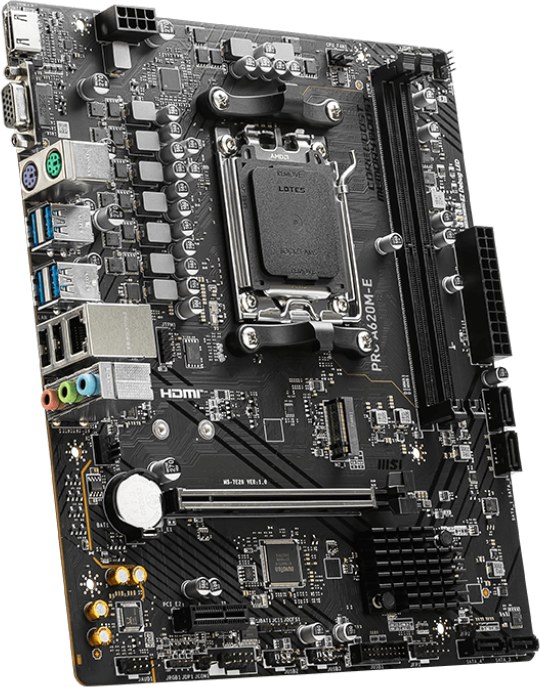
This board will probably be intended mainly for low-end computers (it has HDMI and analog D-Sub video outputs), it lacks USB-C or 10Gb/s ports, the Ethernet is gigabit and the sound system is only Realtek ALC897. Also, there is no longer a USB BIOS flashback button on the rear panel. In return, the price of this particular board is said to be at those starting 85 USD (without sales tax)/ 95 EUR (with VAT).
So the price of this model will be just about roughly 20 dollars (20 to 25 € with EU VAT) above the cheapest LGA 1700 boards with H610 chipset for Intel Core 12th and 13th generation processors. However, it is possible that over time the price of the most basic A620 models will get even closer.
Biostar
The Biostar A620MP-E Pro could also be quite cheap (probably under 100 USD / 110 EUR after EU VAT). This is a board with a simple heatsink on the power delivery and with four DIMM slots for DDR5 memory, but in return it has only one M.2 slot (PCIe 4.0 ×4) for SSD. Interestingly, however, Biostar has fitted three PCIe ×1 slots and two of them are actually PCIe 4.0 ×1 coming from the processor, giving its board the best expansion possibilities in this regard. Plus, one slot is even placed above the PCIe 4.0×16 slot for graphics cards, so it’s not going to end up blocked when fitting a three-slot GPU, which are practically the norm today. Too bad other manufacturers don’t do this as well.
The board doesn’t have USB-C in the back, but it does provide a USB-C connector for the front of the case. And it’s even running at 10Gb/s speed (USB 3.2 Gen 2), whereas all the previous models were only providing 5Gb/s USB-C headers – kudos to Biostar). This board also has 2.5Gb/s Ethernet as a plus (Realtek RTL8125B), but the audio is still ALC897. Like on all other A620 boards, sadly. The board is listed to support 170W Ryzen CPUs, including the 7950X, but how well they will perform on this (or other A620s) is hard to say.
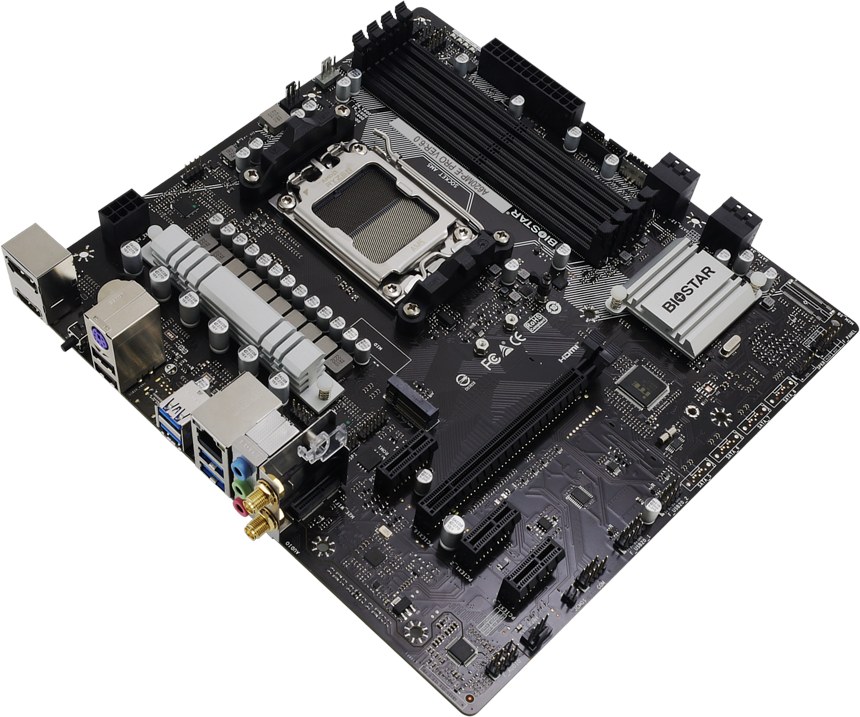
This board is interesting in one more way. It doesn’t have a Wi-Fi module directly included, although you can see connectors on the back panel that would suggest it. This is because Biostar, like ASRock, fits an M.2 connector, to which you can add Wi-Fi yourself (this is nice if you can get a cheap module bought second-hand or even salvaged from some broken laptop). But unlike ASRock, Biostar also preinstalls the appropriate cables and screw connectors on the back panel, so you don’t have to worry about finding them if you want to install a wireless card – you just need to get some type of external antennas (which can be salvaged from discarded routers…).
ASRock
Only ASRock so far has both cheap and more robust but more expensive models at the same time. We’ve already written about its A620M-HDV/M.2 board. The company will also have the A620M-HDV/M.2+, which ends up differing from the basic version way more than originally expected. Not only does it have a heatsink on the VRM, but it also boost it to 6+1+1 phases, while the non-plus model only has a 4+1+1 phase VRM. Thus, the more expensive version can probably handle more powerful CPUs, while for the lower one we would probably recommend only the 65W models.
The Plus board actually has a different PCB with four SATA ports and additional USB ports. It still only provides two DIMM slots, but has two PCIe 4.0×4 M.2 slots for SSDs, while the M.2 non-plus model actually runs the second slot in PCIe 3.0×2 mode. There is just a gigabit Realtek Ethernet on both boards. Unless the A620M-HDV/M.2+ costs more than maybe 15 or so USD over the basic version, it will probably be worth the extra cost.

In addition, ASRock has two fancier boards with yet another (third) PCB, which already has a VRM with 6+2+1 phases (and with a larger VRM heatsink as well as a heatsink for the secondary phases above the socket). These are the A620M Pro RS and A620M Pro RS Wi-Fi. The second is again the same board as the first, but with a 6E Wi-Fi wireless module (2×2 MU-MIMO) plus Bluetooth preinstalled.
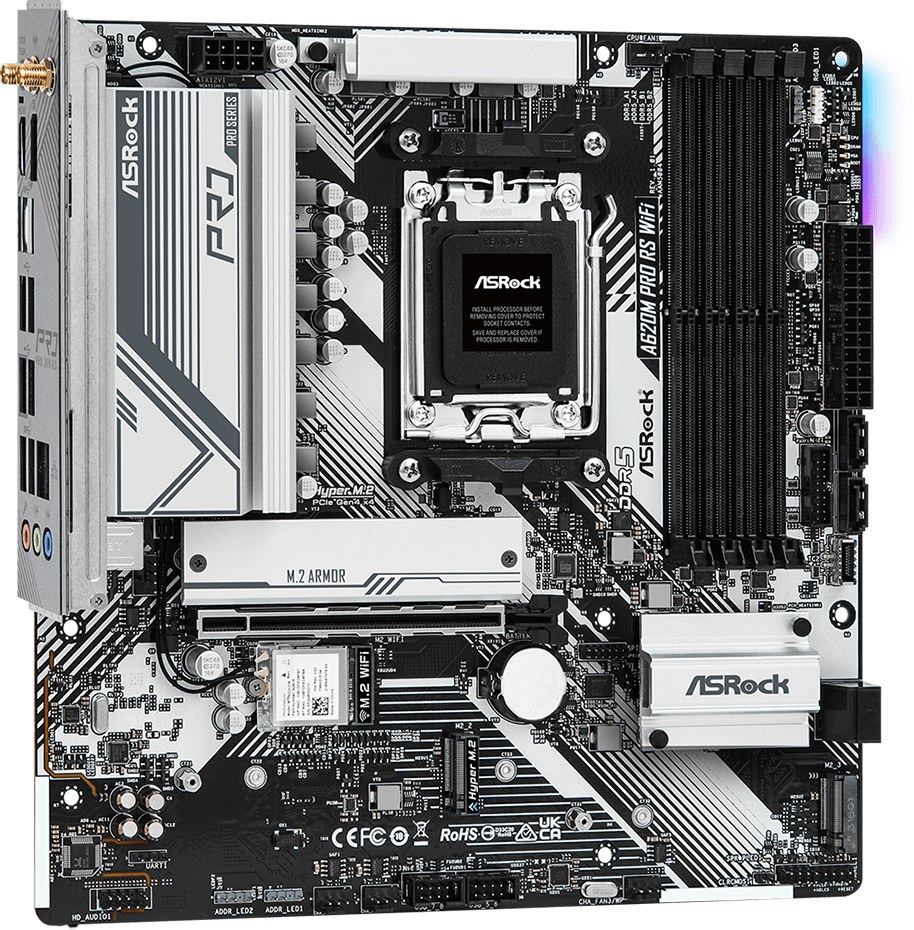
These boards already have four DIMM slots for DDR5 memory, but unfortunately like the others they still only provide Realtek ALC897 sound cards. Also, they don’t have 2.5Gb/s Ethernet, there still just gigabit controller integrated. ASRock’s boards unfortunately don’t do 10Gb/s USB 3.2 Gen 2 (only Gigabyte and Biostar do), but the two Pro RS boards at least have a connector for 5Gb/s USB-C for case front panel.
What’s interesting about these boards: compared to the other models, this pair is unique in having three M.2 slots for NVMe SSDs. Two PCIe 4.0×4 connectivity slots are connected to the processor, and there’s a third PCIe 3.0×2 M.2 slot connected to the A620 chipset. However, this third slot seems to have caused these boards to have zero PCIe 3.0 ×1 slots for expansion cards, there is only the PCIe 4.0 ×16 for graphics cards and nothing else, which is a shame. Watch out for this, as you may find yourself lacking this slot in the future, although a lot can be made up for with external USB peripherals. The PCIe ×1 slots on mATX boards are also often blocked in gaming PCs with three-slot graphics cards (averted by Biostar), so a third M.2 slot might be more useful for someone.
Sources: ASRock, Asus, Gigabyte, WCCFtech, Planet3DNow
English translation and edit by Jozef Dudáš
⠀





